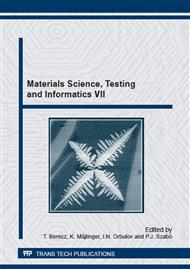[1]
E.A. Ashley, J. Niebauer, Cardiology Explained, Chapter 5: Coronary artery disease, Remedica, London, (2004).
Google Scholar
[2]
M.J. Stampfer, F.B. Hu, J.E. Manson, E.B. Rimm, W.C. Willett Primary, Prevention of Coronary Heart Disease in Women through Diet and Lifestyle, The New England Journal of Medicine, 343 (2000) 16-22.
DOI: 10.1056/nejm200007063430103
Google Scholar
[3]
Peter Lanzer, Mastering Endovascular Techniques: A Guide to Excellence. Lippincott Williams & Wilkins, (2007).
Google Scholar
[4]
Gy. Meszlényi, P. Nagy, Sz. Bella, J. Dobránszky, Laser beam cutting and welding of coronary stents, Welding & Material Testing, 14: 2 (2008) 17-26.
Google Scholar
[5]
B. Katona, P. Nagy, E. Bognár, K. Hirschberg, Development of nitinol stents: etching experiments, Materials Science Forum, 729 (2013) 240-245.
DOI: 10.4028/www.scientific.net/msf.729.240
Google Scholar
[6]
Á. Lengyel, P. Nagy, E. Bognár, K. Hirschberg, Development of nitinol stents: electropolishing experiments, Materials Science Forum, 729 (2013) 436-441.
DOI: 10.4028/www.scientific.net/msf.729.436
Google Scholar
[7]
B. Katona, E. Bognár, B. Berta, P. Nagy, K. Hirschberg, Chemical etching of nitinol stents, Acta of Bioengineering and Biomechanics, 15: 4 (2013) 2-8.
Google Scholar
[8]
MSZ EN ISO 25539-2: Cardiovascular implants. Endovascular devices. Part 2: Vascular stents. (ISO 25539-2: 2013).
DOI: 10.2345/9781570204807.ch1
Google Scholar
[9]
Gy. Ring, E. Bognár, Zs. Bálint-Pataki, J. Dobránszky, Different properties of coronary stents, Anyagok világa, 7: 2 (2007) 1-7.
Google Scholar
[10]
T. Takács, E. Bognár, J. Dobránszky, Az újraszűkülést befolyásoló műszaki paraméterek vizsgálata coronariastenteken, Lege Artis Mediciane, 20 (2010) 227-233.
Google Scholar
[11]
T. Balázs, E. Bognár, E. Zima, J. Dobránszky, Mechanical properties of coronary vein – in vitro evaluation of longitudinal and transversal samples, Biomechanica Hungarica 3: 1 (2010) 24-32.
DOI: 10.17489/biohun/2010/1/02
Google Scholar
[12]
H. Hara, M. Nakamura, J.C. Palmaz, R.S. Schwartz, Role of stent design and coatings on restenosis and thrombosis, Advanced Drug Delivery Reviews, 58 (2006) 377-386.
DOI: 10.1016/j.addr.2006.01.022
Google Scholar
[13]
A. Roguin, E. Grenadier, Stent-based percutaneous coronary interventions in small coronary arteries, Acute Card Care, 8: 2 (2006) 70-74.
DOI: 10.1080/17482940600750382
Google Scholar
[14]
Gy. Ring, E. Bognár, J. Dobránszky, J. Ginsztler, L. Major, Mechanical behaviours of coronary stents. Advances in Science and Technology, 49 (2006) 91-96.
Google Scholar


